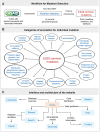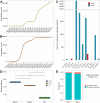COV2Var, a function annotation database of SARS-CoV-2 genetic variation
- PMID: 37897356
- PMCID: PMC10767816
- DOI: 10.1093/nar/gkad958
COV2Var, a function annotation database of SARS-CoV-2 genetic variation
Abstract
The COVID-19 pandemic, caused by the coronavirus SARS-CoV-2, has resulted in the loss of millions of lives and severe global economic consequences. Every time SARS-CoV-2 replicates, the viruses acquire new mutations in their genomes. Mutations in SARS-CoV-2 genomes led to increased transmissibility, severe disease outcomes, evasion of the immune response, changes in clinical manifestations and reducing the efficacy of vaccines or treatments. To date, the multiple resources provide lists of detected mutations without key functional annotations. There is a lack of research examining the relationship between mutations and various factors such as disease severity, pathogenicity, patient age, patient gender, cross-species transmission, viral immune escape, immune response level, viral transmission capability, viral evolution, host adaptability, viral protein structure, viral protein function, viral protein stability and concurrent mutations. Deep understanding the relationship between mutation sites and these factors is crucial for advancing our knowledge of SARS-CoV-2 and for developing effective responses. To fill this gap, we built COV2Var, a function annotation database of SARS-CoV-2 genetic variation, available at http://biomedbdc.wchscu.cn/COV2Var/. COV2Var aims to identify common mutations in SARS-CoV-2 variants and assess their effects, providing a valuable resource for intensive functional annotations of common mutations among SARS-CoV-2 variants.
© The Author(s) 2023. Published by Oxford University Press on behalf of Nucleic Acids Research.
Figures





Similar articles
-
AnnCovDB: a manually curated annotation database for mutations in SARS-CoV-2 spike protein.Database (Oxford). 2025 Feb 12;2025:baaf002. doi: 10.1093/database/baaf002. Database (Oxford). 2025. PMID: 39937661 Free PMC article.
-
SARS-CoV-2 Entry Related Viral and Host Genetic Variations: Implications on COVID-19 Severity, Immune Escape, and Infectivity.Int J Mol Sci. 2021 Mar 17;22(6):3060. doi: 10.3390/ijms22063060. Int J Mol Sci. 2021. PMID: 33802729 Free PMC article. Review.
-
Evolutionary Tracking of SARS-CoV-2 Genetic Variants Highlights an Intricate Balance of Stabilizing and Destabilizing Mutations.mBio. 2021 Aug 31;12(4):e0118821. doi: 10.1128/mBio.01188-21. Epub 2021 Jul 20. mBio. 2021. PMID: 34281387 Free PMC article.
-
COVID-19 Challenge: A Quest for Effective Vaccine Strategies Against Circulating and Emerging SARS-CoV-2 Variants.Curr Pharm Des. 2022;28(35):2901-2913. doi: 10.2174/1381612828666220701160116. Curr Pharm Des. 2022. PMID: 35786330 Review.
-
Functional mutations of SARS-CoV-2: implications to viral transmission, pathogenicity and immune escape.Chin Med J (Engl). 2022 May 20;135(10):1213-1222. doi: 10.1097/CM9.0000000000002158. Chin Med J (Engl). 2022. PMID: 35788093 Free PMC article.
Cited by
-
The NSP6-L260F substitution in SARS-CoV-2 BQ.1.1 and XBB.1.16 lineages compensates for the reduced viral polymerase activity caused by mutations in NSP13 and NSP14.J Virol. 2025 Jun 17;99(6):e0065625. doi: 10.1128/jvi.00656-25. Epub 2025 May 13. J Virol. 2025. PMID: 40358207 Free PMC article.
-
GRAMEP: an alignment-free method based on the maximum entropy principle for identifying SNPs.BMC Bioinformatics. 2025 Feb 25;26(1):66. doi: 10.1186/s12859-025-06037-z. BMC Bioinformatics. 2025. PMID: 40000933 Free PMC article.
-
Characterization of SARS-CoV-2 intrahost genetic evolution in vaccinated and non-vaccinated patients from the Kenyan population.J Virol. 2025 Jun 17;99(6):e0048225. doi: 10.1128/jvi.00482-25. Epub 2025 May 6. J Virol. 2025. PMID: 40326760 Free PMC article.
-
Emergence of Omicron FN.1 a descendent of BQ.1.1 in Botswana.Virus Evol. 2024 Nov 22;10(1):veae095. doi: 10.1093/ve/veae095. eCollection 2024. Virus Evol. 2024. PMID: 39720788 Free PMC article.
-
The 2024 Nucleic Acids Research database issue and the online molecular biology database collection.Nucleic Acids Res. 2024 Jan 5;52(D1):D1-D9. doi: 10.1093/nar/gkad1173. Nucleic Acids Res. 2024. PMID: 38035367 Free PMC article.
References
-
- Markov P.V., Ghafari M., Beer M., Lythgoe K., Simmonds P., Stilianakis N.I., Katzourakis A.. The evolution of SARS-CoV-2. Nat. Rev. Microbiol. 2023; 21:361–379. - PubMed
-
- Lauring A.S., Hodcroft E.B.. Genetic variants of SARS-CoV-2-what do they mean. JAMA. 2021; 325:529–531. - PubMed
-
- Xie X., Liu Y., Liu J., Zhang X., Zou J., Fontes-Garfias C.R., Xia H., Swanson K.A., Cutler M., Cooper D. Neutralization of SARS-CoV-2 spike 69/70 deletion, E484K and N501Y variants by BNT162b2 vaccine-elicited sera. Nat. Med. 2021; 27:620–621. - PubMed
MeSH terms
Supplementary concepts
Grants and funding
LinkOut - more resources
Full Text Sources
Miscellaneous

